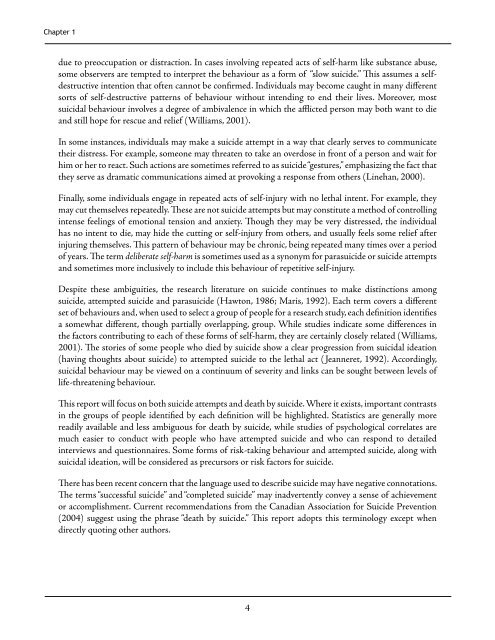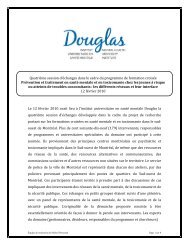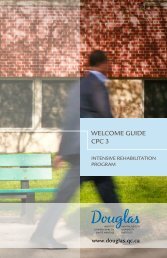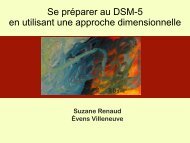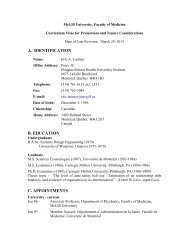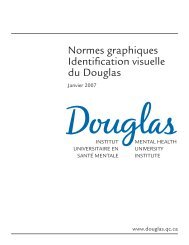Suicide Among Aboriginal People in Canada - Institut universitaire ...
Suicide Among Aboriginal People in Canada - Institut universitaire ...
Suicide Among Aboriginal People in Canada - Institut universitaire ...
Create successful ePaper yourself
Turn your PDF publications into a flip-book with our unique Google optimized e-Paper software.
Chapter 1due to preoccupation or distraction. In cases <strong>in</strong>volv<strong>in</strong>g repeated acts of self-harm like substance abuse,some observers are tempted to <strong>in</strong>terpret the behaviour as a form of “slow suicide.” This assumes a selfdestructive<strong>in</strong>tention that often cannot be confirmed. Individuals may become caught <strong>in</strong> many differentsorts of self-destructive patterns of behaviour without <strong>in</strong>tend<strong>in</strong>g to end their lives. Moreover, mostsuicidal behaviour <strong>in</strong>volves a degree of ambivalence <strong>in</strong> which the afflicted person may both want to dieand still hope for rescue and relief (Williams, 2001).In some <strong>in</strong>stances, <strong>in</strong>dividuals may make a suicide attempt <strong>in</strong> a way that clearly serves to communicatetheir distress. For example, someone may threaten to take an overdose <strong>in</strong> front of a person and wait forhim or her to react. Such actions are sometimes referred to as suicide “gestures,” emphasiz<strong>in</strong>g the fact thatthey serve as dramatic communications aimed at provok<strong>in</strong>g a response from others (L<strong>in</strong>ehan, 2000).F<strong>in</strong>ally, some <strong>in</strong>dividuals engage <strong>in</strong> repeated acts of self-<strong>in</strong>jury with no lethal <strong>in</strong>tent. For example, theymay cut themselves repeatedly. These are not suicide attempts but may constitute a method of controll<strong>in</strong>g<strong>in</strong>tense feel<strong>in</strong>gs of emotional tension and anxiety. Though they may be very distressed, the <strong>in</strong>dividualhas no <strong>in</strong>tent to die, may hide the cutt<strong>in</strong>g or self-<strong>in</strong>jury from others, and usually feels some relief after<strong>in</strong>jur<strong>in</strong>g themselves. This pattern of behaviour may be chronic, be<strong>in</strong>g repeated many times over a periodof years. The term deliberate self-harm is sometimes used as a synonym for parasuicide or suicide attemptsand sometimes more <strong>in</strong>clusively to <strong>in</strong>clude this behaviour of repetitive self-<strong>in</strong>jury.Despite these ambiguities, the research literature on suicide cont<strong>in</strong>ues to make dist<strong>in</strong>ctions amongsuicide, attempted suicide and parasuicide (Hawton, 1986; Maris, 1992). Each term covers a differentset of behaviours and, when used to select a group of people for a research study, each def<strong>in</strong>ition identifiesa somewhat different, though partially overlapp<strong>in</strong>g, group. While studies <strong>in</strong>dicate some differences <strong>in</strong>the factors contribut<strong>in</strong>g to each of these forms of self-harm, they are certa<strong>in</strong>ly closely related (Williams,2001). The stories of some people who died by suicide show a clear progression from suicidal ideation(hav<strong>in</strong>g thoughts about suicide) to attempted suicide to the lethal act ( Jeanneret, 1992). Accord<strong>in</strong>gly,suicidal behaviour may be viewed on a cont<strong>in</strong>uum of severity and l<strong>in</strong>ks can be sought between levels oflife-threaten<strong>in</strong>g behaviour.This report will focus on both suicide attempts and death by suicide. Where it exists, important contrasts<strong>in</strong> the groups of people identified by each def<strong>in</strong>ition will be highlighted. Statistics are generally morereadily available and less ambiguous for death by suicide, while studies of psychological correlates aremuch easier to conduct with people who have attempted suicide and who can respond to detailed<strong>in</strong>terviews and questionnaires. Some forms of risk-tak<strong>in</strong>g behaviour and attempted suicide, along withsuicidal ideation, will be considered as precursors or risk factors for suicide.There has been recent concern that the language used to describe suicide may have negative connotations.The terms “successful suicide” and “completed suicide” may <strong>in</strong>advertently convey a sense of achievementor accomplishment. Current recommendations from the Canadian Association for <strong>Suicide</strong> Prevention(2004) suggest us<strong>in</strong>g the phrase “death by suicide.” This report adopts this term<strong>in</strong>ology except whendirectly quot<strong>in</strong>g other authors.


